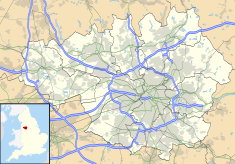Altrincham Town Hall is a municipal building in Market Street, Altrincham, Greater Manchester, England. The town hall was the headquarters of Altrincham Borough Council.
| Altrincham Town Hall | |
|---|---|
 Altrincham Town Hall | |
| Location | Market Street, Altrincham |
| Coordinates | 53°23′16″N 2°21′08″W / 53.3878°N 2.3522°W |
| Built | 1901 |
| Architect | Charles Albert Hindle |
| Architectural style(s) | Jacobean style |
History
editThe first town hall in Altrincham was a small neoclassical structure in the Old Market Place built in brick with white stucco and completed in 1849.[1] It was commissioned by the Earl of Stamford whose country seat was at Dunham Massey Hall.[2] The design involved a symmetrical main frontage with three bays facing onto the Old Market Place; the left hand bay contained a carriage entrance while the other two bays contained round headed windows. The central bay, which slightly projected forward, featured an oriel window on the first floor and a clock tower with a bellcote and a weather vane above.[3][4] The original borough of Altrincham was administered by a court leet, which met in the council chamber on the first floor,[1] until it was abolished under the Municipal Corporations Act 1883.[5]
Following significant industrial growth, particularly in the Broadheath area after the businessman, Benjamin Tilghman, established the town as the British hub of the sandblasting industry,[6] Altrincham became an urban district in 1895.[7] In this context, the new council decided to procure a new town hall: the site selected on the corner of Market Street and Dunham Road was occupied by a private property equipped with coach house and stables.[8]
A design competition for the new building was assessed by John Ely, President of the Manchester Association of British Architects, and won by Charles Albert Hindle.[9] Construction started in 1899 although it was delayed while the builder removed an uncharted water cistern.[9] The new building was designed in the Jacobean style, built in red brick with stone dressings at a cost of £7,500 and officially opened in November 1901.[9] The original design (the central and right hand sections of the current building) involved an asymmetrical main frontage with five bays facing onto Market Street with the right hand bay featuring a Jacobean style gable containing a date stone; the central section of three bays, which slightly projected forward, featured a porch flanked by pilasters supporting an open pediment; there were mullioned windows on the first floor and an entablature carved with the name "Altrincham Town Hall" above. The building was extended to the south west by two extra bays in 1930 with the left hand end bay also featuring a Jacobean style gable containing a date stone so giving the building its current symmetry.[10]
Further population growth, in part driven by the construction and expansion of the facilities operated the Linotype and Machinery Company,[11] led to the area becoming a municipal borough with the town hall as its headquarters in 1937.[7] The town hall ceased to be the local seat of government when the enlarged Trafford Council was formed in 1974.[12][13] An extensive programme of restoration works was completed in 2006, so enabling the building to serve as a venue for marriages and civil partnership ceremonies.[14] A statue depicting a market trader which had been sculpted by Colin Spofforth was unveiled outside the town hall by the Mayor of Trafford, Councillor Bernard Sharp, on 9 May 2008;[15][16] a commemorative stone celebrating the Diamond Jubilee of Elizabeth II was erected there in spring 2012[17] and, following a crowdfunding campaign, a six-foot aluminium silhouette of a First World War soldier was installed outside the town hall in November 2018.[18]
Works of art in the town hall include a painting by Tom Colley depicting troops loyal to the pretender to the throne, Charles Edward Stuart, seeking accommodation at The Red Lion Inn at Altrincham on 1 December 1745 during the Jacobite rising.[19]
References
edit- ^ a b "Altrincham Walk". This is Cheshire. Archived from the original on 3 December 2013. Retrieved 8 March 2021.
- ^ "Couple snubbed by Victorian society are celebrated in old home". The Guardian. 23 February 2016. Retrieved 8 March 2021.
- ^ Historic England. "The Old Market Tavern (1067960)". National Heritage List for England. Retrieved 6 March 2021.
- ^ Hartwell, Clare; Hyde, Matthew; Hubbard, Edward; Pevsner, Nikolaus (2011) [1971], Cheshire, The Buildings of England, Yale University Press, p. 101, ISBN 978-0-300-17043-6
- ^ Municipal Corporations Act 1883 (46 & 46 Vict. Ch. 18) (PDF). 1883. Retrieved 26 March 2023.
- ^ "Tilghman's Patent Sand Blast Co".
- ^ a b "Altrincham MB/UD". Vision of Britain. Retrieved 8 March 2021.
- ^ Bayliss, Don (2006). "A Town in Crisis: Altrincham in the Mid-Nineteenth Century" (PDF). p. 35.
- ^ a b c "Booklet traces the history of Altrincham Town Hall". Messenger Newspapers. 3 May 2016. Retrieved 9 March 2021.
- ^ "Altrincham Town Hall". Manchester Victorian Architects. Retrieved 8 March 2021.
- ^ "The Linotype Estate". Visit Manchester. Retrieved 8 March 2021.
- ^ Local Government Act 1972. 1972 c.70. The Stationery Office Ltd. 1997. ISBN 0-10-547072-4.
- ^ "Interesting facts you may not know about Altrincham". Messenger Newspapers. 7 February 2014. Retrieved 8 March 2021.
- ^ "Old Market Place Conservation Area Conservation Area Appraisal" (PDF). Trafford Council. 1 October 2014. p. 43. Retrieved 8 March 2021.
- ^ "'Grotesque' £35K statue slammed". Manchester Evening News. 29 August 2007. Retrieved 9 March 2021.
- ^ "Wraps come off town's new statue". Messenger Newspapers. 8 May 2008. Retrieved 9 March 2021.
- ^ "Altrincham Town Hall" (PDF). Altrincham & Bowdon Civic Society. 1 November 2014. p. 4. Retrieved 8 March 2021.
- ^ "Six-foot aluminium 'Tommy' installed in Altrincham town centre after locals' crowdfunding campaign". Altrincham Today. 9 November 2018. Retrieved 8 March 2021.
- ^ "The Pretender's Troops Demanding Billets at the 'Red Lion' Inn, Altrincham, 1 December 1745". Art UK. Retrieved 8 March 2021.
